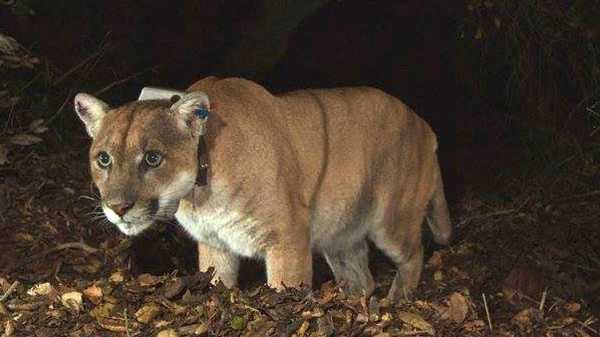
The citizens of Los Angeles have not forgotten about P-22, the furtively majestic mountain lion of Griffith Park, who died a week before Christmas, at the age of about twelve. A handsome beast with amber eyes and a white muzzle, P-22 was probably born in the Santa Monica Mountains, the coastal range west of L.A. His father was P-1, the first animal to have been tagged in a National Park Service mountain-lion study that began in 2002. (“P” stands for puma; the cats are known variously as pumas, mountain lions, panthers, catamounts, and cougars.) At the age of around one and a half, P-22 made a perilous twenty-mile journey eastward, presumably in search of uncontested territory. He crossed Interstate 405; loped through the hills above Westside L.A.; traversed the 101; and reached a reasonably safe haven in Griffith Park, a forty-two-hundred-acre expanse of urban wilderness northeast of Hollywood. In 2012, the biologist Miguel Ordeñana was reviewing images from a remote camera in the park when he saw, to his amazement, the sturdy hindquarters of a massive feline. There had been occasional puma sightings in the park, but no one had conceived of a big cat residing there full time.
The L.A. Times reported P-22’s existence in 2013, and his rise to fame began. A photographer from National Geographic caught an image of him prowling at night, with the Hollywood sign aglow on the hill above. Two homeowners in Los Feliz, a neighborhood south of Griffith Park, discovered him resting placidly in a crawl space. Dozens of other residents recorded glimpses of P-22 on doorbell cameras. When, in 2016, he became the lead suspect in the death of a koala at the Los Angeles Zoo, a local politician argued that he should be removed, but no action was taken. Instead, the L.A. City Council instituted P-22 Day, which became a yearly celebration in Griffith Park. Songs were written, documentaries filmed, school curricula devised. P-22’s renown crossed the ocean; the Guardian dubbed him the “Brad Pitt of mountain lions,” in reference both to his fetching looks and to his inability to find a mate.
Mountain lions tend not to live much longer than ten years, and toward the end P-22 began exhibiting signs of decline. For a decade, he had been fairly cautious in his movements, but in 2022 he wandered farther afield, showing up south of the Silver Lake Reservoir, more than two miles from the park. Departing from his usual diet—deer were his favorite meal—he stalked and killed a Chihuahua, even though the dog was walking with its owner. A second Chihuahua attack was foiled when the owner fought back. Such behavior was atypical for a cat who had previously avoided humans. Officials elected to capture P-22 and assess his condition. He was tracked to a spot near the Shakespeare Bridge, in Los Feliz. He had recently been struck by a car and was suffering from kidney disease and other ailments. After days of deliberation, the decision was made to euthanize him. Officials broke into tears as they announced the news. His obituary ran on the front page of the L.A. Times, above the fold.
In early February, Beth Pratt, a regional executive director at the National Wildlife Federation, organized a memorial at the Greek Theatre, in Griffith Park. Several thousand people attended, many outfitted in appropriate gear. (I wore a #SaveLACougars T-shirt.) The ceremony ran about as long as the Oscars and included appearances by the d.j. and producer Diplo, who toted a stuffed P-22 toy; the actor and comedian Rainn Wilson, who performed a song that rhymed “22” with “poo”; and Representative Adam Schiff, who proudly identified himself as “P-22’s representative in Congress.” The loveliest tributes came from schoolkids. Nineteen students from San Pascual Elementary School, in Highland Park, offered their own anthem, titled “P-22, We Love You,” accompanying themselves on ukuleles.
Earlier this month, P-22’s remains were buried at an undisclosed location in the Santa Monica Mountains, in a ceremony presided over by Native tribal leaders. City Council members have called for a permanent memorial in Griffith Park, perhaps in the form of a statue. There will be a musical memorial, too. The L.A. Philharmonic has commissioned the composer Adam Schoenberg to write a work in honor of P-22, to be titled “Cool Cat”; it will have its première this summer, at the Hollywood Bowl.
Outsiders may be wondering what the fuss is all about. The obvious response would be to file the P-22 phenomenon away in the commodious annals of L.A. kookiness. You could see him as one more celebrity known chiefly for being famous—a feline successor to Angelyne. That would be a little facile, though. As one mourner at the Greek Theatre commented, P-22 was “far more beloved than most actual celebrities in Los Angeles.” His death triggered a palpable wave of public sadness, particularly in the neighborhoods where he made his rounds. The idea that he was out there somewhere had lent an air of mystery to the murmuring nights.
The love for P-22 is probably rooted in the age-old Californian dream of dwelling amid nature—a dream that has not been foreclosed by the paving over of much of the Los Angeles Basin. The decentered sprawl of L.A. living means that a surprising amount of green steals into the cityscape. This is especially true of the wealthier neighborhoods in the hills, the ones that abut the mountains and canyons. Streets are lined with trees, the yards ramble. The lavish documentation of P-22’s life attests, more than anything, to the prevalence of high-tech surveillance systems in upscale areas. The countless videos were a charming by-product of the paranoid, gated-community mentality that the late Mike Davis anatomized in his book “City of Quartz,” a classic dismantling of L.A’s mythic self-image.
Despite the groaning iniquities of the surrounding real estate, Griffith Park is hugely popular with Angelenos of all backgrounds. It’s hilly, semi-mountainous terrain, crisscrossed by hiking paths. Once you’re deep into it, you can forget the metropolis around you. The primal yearning for open space, which drew millions to Los Angeles in the early twentieth century, helps to explain why P-22 became the subject of an unusual kind of cross-species identification. Laura J. Nelson and James Queally, in their L.A. Times obituary, wrote, “Many Angelenos saw themselves in P-22, an aging bachelor who adjusted to a too-small space in the big city, waiting for a mate who might never arrive.” Ordeñana, P-22’s discoverer, said, “Crossing the border, being persecuted in some areas of the country—people feel a connection with that.”
When questions about P-22’s perceived misbehavior arose, another factor came into play: a reconsideration of the idea that human lives and human fears matter above all else. In the end, the constituency of people who felt threatened by P-22 proved to be small. Of course, it helped that he never injured a human, as mountain lions have very occasionally done elsewhere. But the shift in consciousness, from control to coexistence, was notable all the same. A long-standing proposal to build a wildlife bridge over the 101 gained support, in large part because of P-22’s fame. (Dozens of pumas have died on roadways.) The bridge, called the Wallis Annenberg Wildlife Crossing, is now under construction and is scheduled to open in 2025. A letter writer to the L.A. Times proposed that the structure would be more aptly named the P-22, in keeping with the quirky local habit of attaching the definite article to freeways.
I have been thinking about P-22 lately because my husband and I had to say goodbye to a much smaller cat—a fourteen-year-old Abyssinian named Beatrice, or Bea. Abyssinians are among the liveliest of domestic breeds, svelte and leonine in appearance. Bea, true to form, darted around our home as if it were a fascinating and vaguely fraught patch of tundra. Cats are often said to reveal their personalities subtly, over time. This was not the case with Bea, who startled our guests with her explosive hospitality protocol. She would dance on the kitchen counter, jump on visitors’ shoulders, lick their hair, and explore their ears, all the while issuing whispery meows and pigeonlike chirps. It goes without saying that she was magnificent.
The comedy of catness lies in the juxtaposition of organically sinuous movement with the drab rectangularity of human habitation. Watching cats, you become conscious of the artificiality of our environments. Carpets, for example: Bea never cared for them and studiously walked around them. P-22 had a similar estranging effect on the streets adjoining Griffith Park. A video of him gliding past an array of multicolored garbage bins—green, black, and blue—makes me laugh out loud, because he offers an implicit critique of the extreme ugliness of these objects. I also love a video of him clambering over a fence in someone’s yard. In a very catlike way, he moves with impeccable elegance while making a racket.
How happy was Bea? We were never sure. She appeared to delight in our company, yet she experienced a fair degree of anxiety, bordering on neurosis. She had periodic fits, storming around in a hyperventilating blur. Her stress subsided when we moved from an apartment to a house. Likewise, people wondered about P-22’s quality of life. Forty-two hundred acres would seem to be plenty of space, but it’s actually a tenth of the size of the typical puma habitat. P-22 obviously yearned to roam a wider realm, yet he found no end to the asphalt. He also searched in vain for female companionship, leaving seductive piles of poop. Dana Goodyear, writing about pumas for this publication, said that P-22 was “living out the classic science-fiction narrative of the protagonist who wakes up to discover that he is the last of his kind.” On the other hand, he had freed himself from the tension of territorial rivalries. P-1, his belligerent father, was known to kill his own cubs.
Ultimately, like much of the population, P-22 seemed to be making do with what he had. His crawl-space sit-in, which dominated the local news media for a couple of days, felt like a moment of accommodation. In the face of feeble attempts to get him to move—lights were flashed, sticks were waved, a tennis-ball cannon was deployed—P-22 stared out with an imperturbable expression that members of cat households recognized instantly. It said, “What?” At night, once the brouhaha had died down, P-22 slipped back into the park. He might have concluded that the human world was bizarre, frightening, and insane, but not entirely evil. ♦
Sourse: newyorker.com






